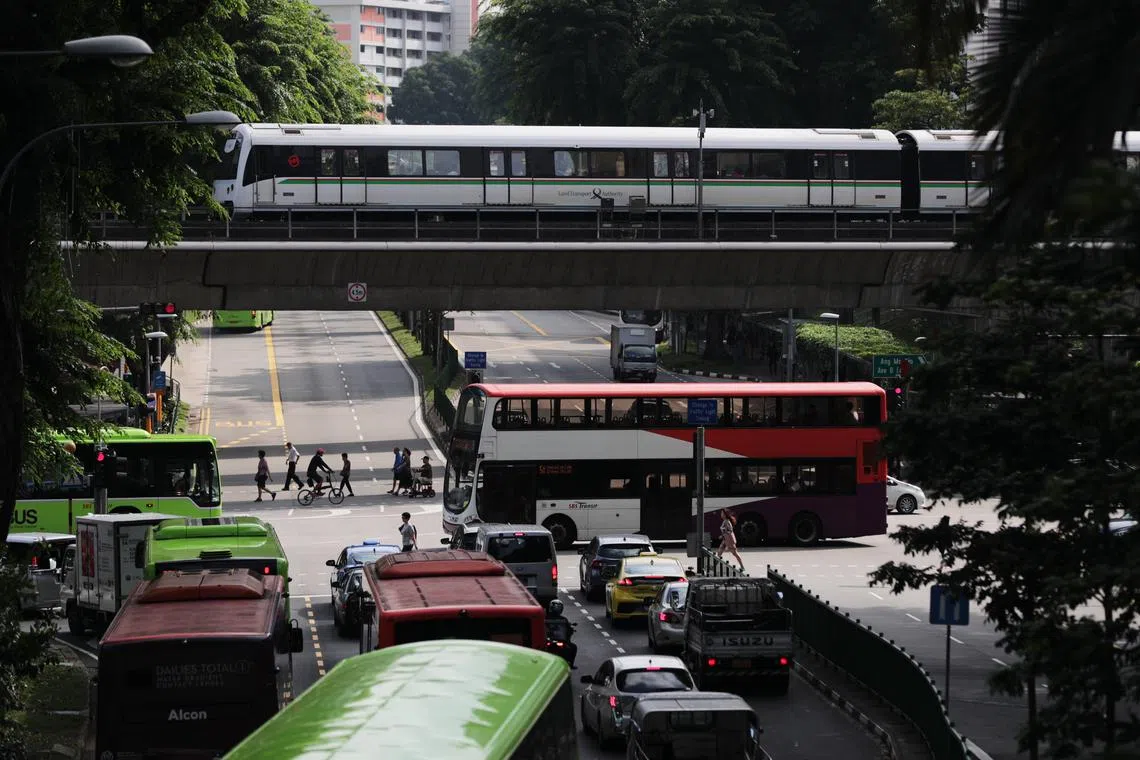Public transport ridership, traffic volumes edge closer to 2019 levels
Sign up now: Get ST's newsletters delivered to your inbox

In October 2023, the average number of bus and train rides taken each day was at about 95 per cent of 2019 levels.
PHOTO: ST FILE
Follow topic:
SINGAPORE – While public transport ridership has continued to grow in 2023, the number of trips taken on buses and trains has not yet returned to the same levels as before the Covid-19 pandemic.
The number of public transport rides into the Central Business District (CBD) on weekday mornings has also remained lower than before the pandemic, trailing overall bus and train usage by some distance. Meanwhile, expressway traffic volumes have continued to inch closer to a full recovery. This has translated into more congestion and rush-hour traffic jams.
Industry experts said these trends likely reflect the increased flexibility that has been adopted for work and business in Singapore after the pandemic, even though the majority of interactions have now gone back to being in-person.
In October 2023, which is the latest period that is most representative of usual public transport usage before the year-end holidays, the average number of bus and train rides taken each day was at about 95 per cent of 2019 levels.
Ridership for buses recovered at a slower pace, with average whole-day ridership at about 93 per cent of pre-pandemic levels in October.
Meanwhile, average whole-day ridership for trains was at 97 per cent of 2019 levels. This is according to statistics given to The Straits Times by the Land Transport Authority (LTA) that did not include the exact ridership figures.
Public transport ridership had already hit 90 per cent of pre-pandemic levels in January 2023, but industry observers had earlier said it would take time before bus and train ridership went back to the all-time highs that were seen in 2019 before the pandemic.
In October 2019, bus and train rides averaged 7.81 million a day – with about 4.17 million for buses and 3.64 million for trains.
In October 2020, about nine months after the coronavirus spread here, this number fell to 5.57 million bus and train rides on average per day, which is about 71 per cent of 2019 levels.
Ridership then fell again, to 4.63 million in October 2021, or about 59 per cent of the number in the same period in 2019, after Singapore tightened its pandemic restrictions that year to slow an exponential rise in Covid-19 cases at the time.
In October 2022, bus and train ridership was back up to 6.76 million, or about 87 per cent of October 2019 levels.
The latest ridership figures provided by LTA have also shown sustained shifts in commuting patterns, industry observers told ST.
According to LTA, the number of bus and train journeys made by workers to the CBD during the weekday morning peak period in October 2023 was at about 80 per cent that of the same period in 2019.
Meanwhile, as at end-October, the traffic volume on expressways stood at around 97 per cent of pre-pandemic levels, and the traffic volume on arterial roads was at about 88 per cent of 2019 levels.
Traffic volume on expressways had already hit around 95 per cent of pre-Covid-19 levels in May 2022, following the easing of most Covid-19 curbs in April that year.
Ms Ray Krishna, head of the Singapore smart mobility department at consultancy firm Ramboll, said the fact that both public transport ridership and expressway traffic volumes are close to pre-pandemic levels shows that Singapore is returning to pre-pandemic travel activity.
But she noted that the number of bus and train rides made to the CBD during the weekday morning peak period is much lower than overall public transport usage, which indicates there is still flexibility for workers to travel to work outside the typical peak hours.
Associate Professor Walter Theseira, head of the urban transportation programme at the Singapore University of Social Sciences, said the CBD public transport data is consistent with what has been observed over the past year or two.
“Although most workplaces have halted full flexibility in terms of working from home, the cumulative effect of work flexibility policies and changes made by organisations in terms of office space use seems to have created this sustained drop in traditional peak hour commuting,” he added.
He also noted that based on LTA’s latest statistics and the fact that the population here is larger now than in 2019, it appears that transport use per capita has gone down.
This poses a challenge for future transport planning as traditionally, investments in public transport are made to cater for peak loads during the weekday rush hours, he said.
“If you really had a sustained reduction in peak load demand, that would allow for cost savings. But we don’t know how realistic that is.”


